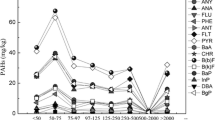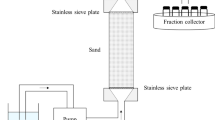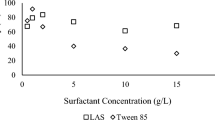Abstract
Tests were conducted to study the influence of non-ionic surfactants Triton X-100 and Tween 80 on the removal of mixed contaminants from a sandy soil using phytoremediation. Cd(II) and Pb(II) were used to form the inorganic contaminant, while used engine oil was selected to form the organic contaminant. The Indian mustard (Brassica juncea) plant was the plant chosen for phytoremediation of the sandy soil that contained the mixed contaminant. Thirty days after the plants were grown in the greenhouse, surfactants were applied to test pots in which the soil had been spiked with 50 mg kg−1 of CdCl2, 500 mg kg−1 of PbCl2 and 500 mg kg−1 of used engine oil. Two control tests were conducted in this study. Planted and unplanted control tests were conducted using soil without surfactants. Following these tests, the tests were completed using the plants and surfactants at different concentrations. Test results showed that Triton X-100 and Tween 80 at concentrations higher than their critical micellar concentration enhanced Cd(II) and Pb(II) accumulation in the plant roots. Further, test data showed that translocation of contaminants to plant shoots occurred for Cd(II) but not for Pb(II). At the same concentrations, Tween 80 was more effective than Triton X-100 in facilitating rhizodegradation of used engine oil. This study demonstrates that simultaneous phytoremediation of Pb(II), Cd(II) and oil can be enhanced by using non-ionic surfactant Tween 80. Leaching test results indicated that the enhanced phytoremediation could remove the mixed contaminants safely from the point of view of limiting groundwater contamination.






Similar content being viewed by others
References
Alkorta, I., Hernández-Allica, J., Becerril, J. M., & Amezaga, I. (2004). Chelate-enhanced phytoremediation of soils polluted with metals. Reviews on Environmental Health, 3, 55–70.
Almeida, R., Claúdia Dias, A., Mucha, P., & Bordalo, A. (2009). Influence of surfactants on the Cu phytoremediation potential of a salt marsh plant. Chemosphere, 75, 135–140.
ASTM. (2006). ASTM standards on environmental sampling. West Conshohocken: ASTM.
Berthouex, P., & Brown, L. (2002). Statistics for environmental engineers. Boca Raton: CRC.
Chen, M., & Ma, L. (1998). Comparison of four digestion methods for trace metal analysis using certified and Florida soils. J. Environ Quality., 27, 1294–1300.
Chu, W., & Chan, K. (2003). The extractants for the removal of mixed e mechanism of the surfactant-aided soil washing system for hydrophobic and partial hydrophobic organics. Science of the Total Environment, 307, 83–92.
Cserhati, T. (1995). Alkyl ethoxylated and alkyphenol ethoxylated nonionic surfactants interaction with bioactive compounds and biological effects. Environ Health Perspective, 103, 358–364.
Duffield, A. R., Ramamurthy, A. S., & Campanelli, J. R. J. (2003). Surfactant enhanced mobilization of mineral oil within porous media. Water Air and Soil Poll, 143, 111–122.
Edwards, D., Adeel, Z., & Luthy, R. (1994). Distribution of non-ionic surfactant and phenanthrene in a sediment/aqueous system. Environmental Science and Technology, 28, 1550–1560.
Epelde, L., Hernández-Allica, J., & Becerril, J. (2008). Effects of chelates on plants and soil microbial community: Comparison of EDTA and EDDS for lead phytoextraction. Science of the Total Environment, 401, 21–28.
Epestein, E. (1972). Mineral nutrition of plants: Principles and perspectives. New York: Wiley.
Gao, Y., Zhu, L., Hu, C., & Chen, B. (2004). Effects of Tween 80 on plant uptake of phenanthrene and pyrene from water. Acta Scientiae Circumstantiae (in Chinese), 24, 713–718.
Kim, I., Park, J., & Kim, K. (2001). Enhanced biodegradation of polycyclic aromatic hydrocarbons using nonionic surfactants in soil slurry. Applied Geochemistry, 16, 1419–1428.
Klumpp, E., Heitman, H., & Schwuger, M. J. (1991). Interactions in surfactant/pollutant/soil mineral systems. Tenside Surfactants Deterg, 28, 441–446.
Maturi, K., & Reddy, K. R. (2008). Extractants for the removal of mixed contaminants from soils. Soil and Sediment Contamination, 17, 586–608.
McQuaker, N., Brown, D., & Kluckner, P. (1979). Digestion of environmental materials for analysis by inductively coupled plasma–atomic emission spectroscopy. Analytical Chemistry, 51, 1082–1084.
National Round Table on the Environment and the Economy. (2003). Cleaning up the past, building the future: A National Brownfield Redevelopment Strategy for Canada. Ottawa: National Round Table on the Environment and the Economy.
Ramamurthy, A., Vo, D., Li, X., & Qu, J. (2008). Surfactant-enhanced removal of Cu (II) and Zn (II) from a contaminated sandy soil. Water Air and Soil Poll, 190, 197–207.
Rmer, W., & Keller, H. (2001). Exudation of organic acids by spinach and the mobilization of Cu, Zn, and Cd in soil. Plant Nutrition., 92, 556–557.
Safwan, S., Jian, C., & Fengxiang, X. (2008). Phytotoxicity of mercury in B. juncea (Brassica juncea L.). Ecotoxicology and Environmental Safety, 72, 619–625.
Saichek, R., & Reddy, K. (2005). Electro kinetically enhanced remediation of hydrophobic organic compounds in soils: A review. Critical Reviews Environ Sci Technol., 35, 115–192.
Santanu, P. (2008). Surfactant-enhanced remediation of organic contaminated soil and water. Advances in Colloid and Interface Science, 138, 24–58.
Soon, A., Dae, S., & Min, W. (2006). Toxicity of phenanthrene dissolved in non-ionic surfactant solutions to Pseudomonas putida P2. FEMS Microbiology Letters, 267, 194–199.
Author information
Authors and Affiliations
Corresponding author
Rights and permissions
About this article
Cite this article
Ramamurthy, A.S., Memarian, R. Phytoremediation of Mixed Soil Contaminants. Water Air Soil Pollut 223, 511–518 (2012). https://doi.org/10.1007/s11270-011-0878-6
Received:
Accepted:
Published:
Issue Date:
DOI: https://doi.org/10.1007/s11270-011-0878-6




